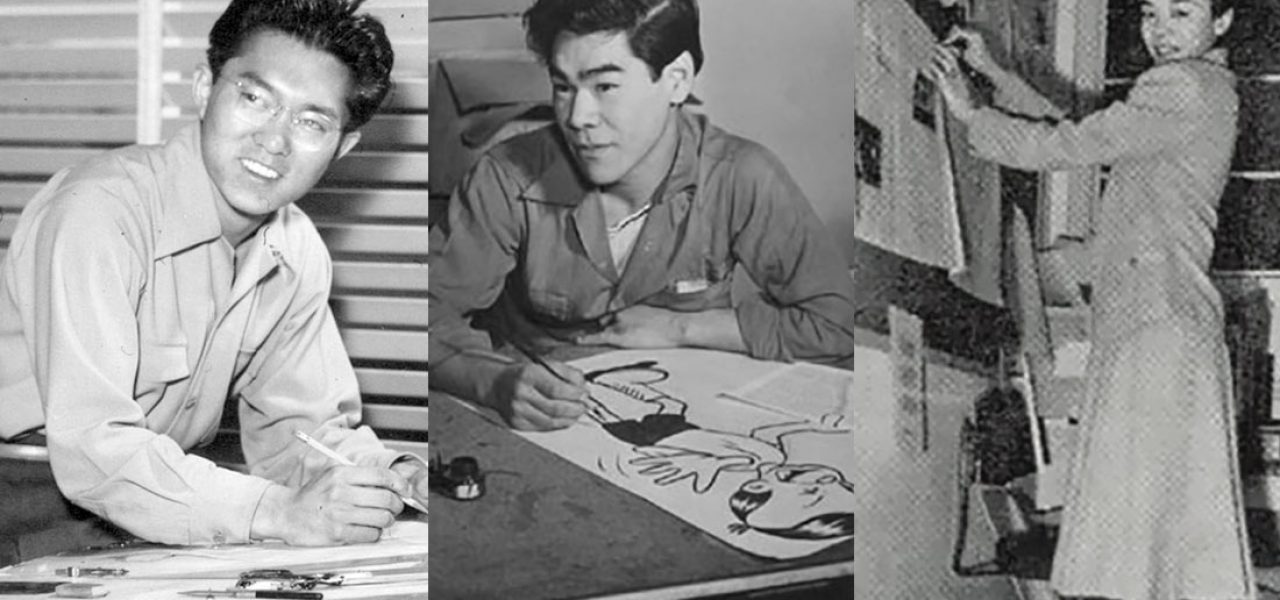
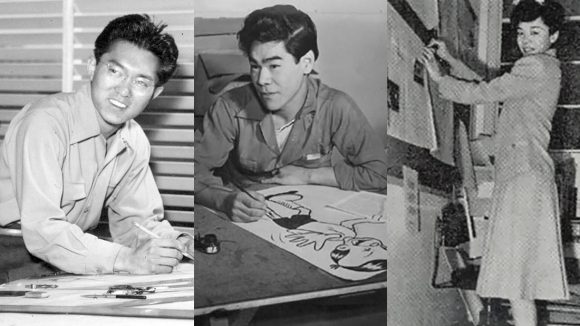
Discover The Pioneering Japanese-American Animation Artists of the Golden Age
Contrary to what most animation histories would lead one to believe, the creative workforce during the Golden Age of animation in the 1930s and 1940s was not comprised entirely of white males. There were also women who worked in creative capacities, as well as artists of different ethnicities, particularly Mexican, Chinese, and Japanese. Sadly their contributions have been obscured throughout the years and rarely acknowledged in any meaningful way by the art form’s historians.
The history of Japanese artists is particularly notable because most of them faced a huge hurdle to joining the animation industry: they were forced into interment camps during World War II. In one of the uglier moments of American history, the U.S. government forcibly and illegally removed tens of thousands of West Coast-based American citizens of Japanese descent from their homes and confined them in concentration camps, an action that the U.S. government later admitted was based on “race prejudice, war hysteria, and a failure of political leadership.”
Recently while browsing through this UC Library digital image archive, I stumbled across some rare photos that help to flesh out the story of Japanese-American animation artists. To start off, here’s a shot of Scooby-Doo character designer Iwao Takamoto taken June 2, 1945:
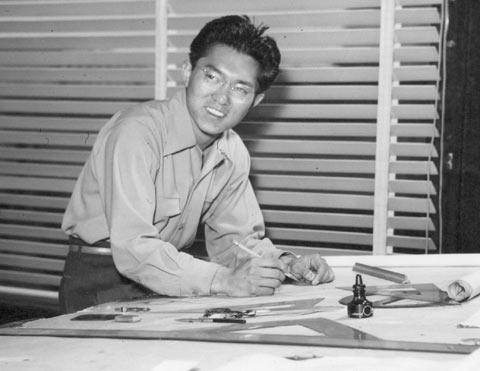
Iwao was too young to work in animation prior to the war. He was hired to work at Disney in 1945 at the age of 20. From the image caption: “Mr. Takamoto’s father, Chitoshi; mother, Akino; brother, Norito; and sister, Kimoko; are all at Manzanar [internment camp]. Iwao graduated from Thomas Jefferson High School in Los Angeles in 1942. How did he get the job at Disney’s? He phoned for an appointment, brought samples of his work, and a week later was hired.”
In an interview I conducted with Iwao in 1999, he spoke in greater detail about his experience being interned and how he entered the animation industry afterwards. By the early-1950s, he had became one of the most trusted clean-up artists at Disney and worked closely with both Milt Kahl and Marc Davis before beginning his long and illustrious H-B career in 1961.
The next photo is Bennie Nobori, who had worked at Disney prior to being interned. I’ve never heard of him but examples of his work from an internment camp newspaper–here and here–reflect a strong Freddie Moore influence.
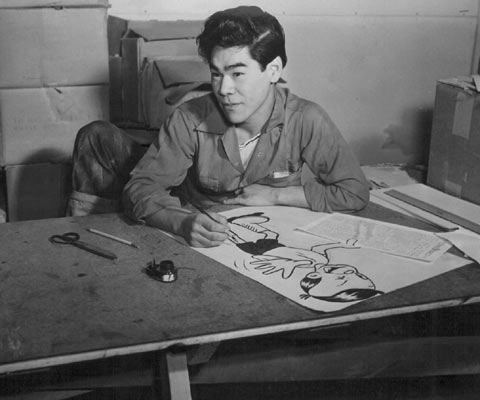
Other Disney artists who were interned during WWII were veteran animator and writer Bob Kuwahara and Chris Ishii. According to Michael Barrier, Kuwahara was “the first Disney artist whose job was just to draw story sketches.” Kuwahara left Disney in 1937 to go to MGM, which is where he was working when he was taken away by the government. After the war, he moved to NY where, among other things, he created the theatrical cartoon character Hashimoto-san for Terrytoons. Read a short bio written by Kuwahara himself here.
I’ve previously written about about Ishii’s WWII experience on the Brew. In that earlier piece, there’s a photo of Ishii working on the camp’s newspaper comic. Below is another photo from December 12, 1942, the day he was inducted into the U.S. military. It has the following caption: “Chris Ishii two years ago worked as an artist for Walt Disney, he tried to join the army but was turned down for slightly flat feet, then his draft board classed him 1-A but before his hopes were realized he was evacuated from California and his new draft number said 4-C, undesirable alien. In the center Chris created, for center newspapers, a cartoon character “Little Neebo”, humorously depicting the trials and tribulations of a little Nisei boy in evacuation centers. Here Chris realizes his deepest ambition as he is finger printed by an army sergeant after having been sworn into the Army of the United States, to be sent to Camp Savage, Minnesota.”
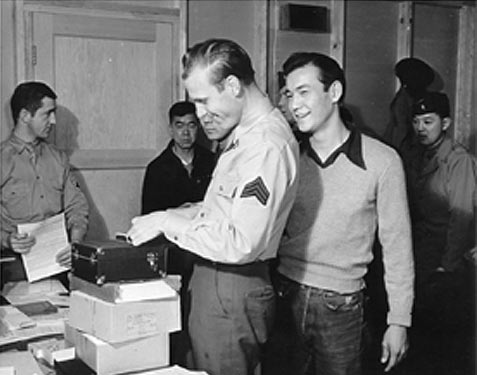
After the war, Ishii became a top East Coast designer and eventually served as the creative director of UPA-NY in the late-1950s as well as co-owner of Focus Productions in the 1960s and 1970s. In the UC image archive, I found a photo of a wooden pin created by Chris Ishii featuring his character Lil’ Neebo.
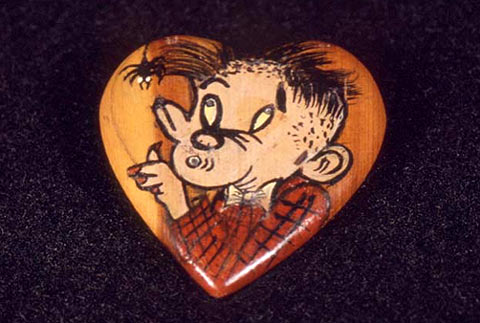
Ishii, who had become an assistant to Ward Kimball in November 1940, went out on stike at Disney in 1941 along with the other Japanese-American artists who worked at the studio including Tom Okamoto, Masao Kawaguchi and James Tanaka. Below is a 1943 photo of James Tanaka working at Famous Studios in New York. The caption accompanying his photo says, “James worked for five years in the studios of Walt Disney and secured his present position [at Famous] while at the Rohwer Relocation Center in Arkansas.”

The archive also has a photo of Tom Inada working at Famous. The photo caption says: “He had just finished a commercial art course at the Sacramento Junior College in California when all persons of Japanese ancestry were evacuated from the west coast. He lived for a year at the Tule Lake Relocation Center.”
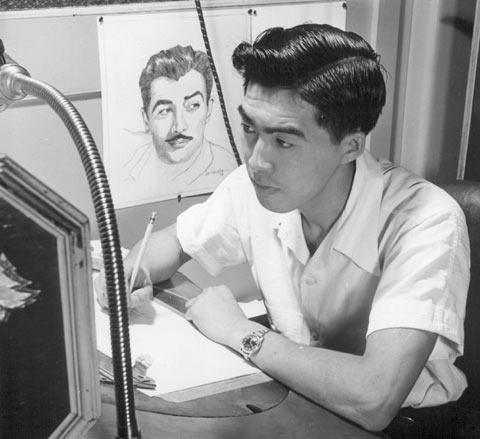
And here’s a pic of Tom Inada and James Tanaka working together at Famous.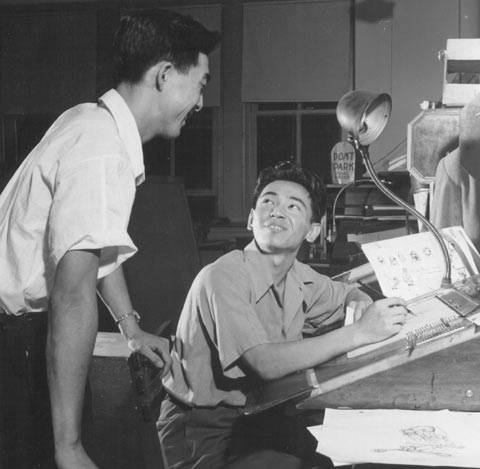
Below is a 1945 image of Michiko Kataoka (second from left), who had been interned at Manzanar and was attending UCLA at the time of this photo. Judging from her age in the photo and the uniqueness of the name, I’d harbor a guess that she is the artist who went by the name of Michi Kataoka and who worked at UPA as a background painter for a brief period in the early-1950s.
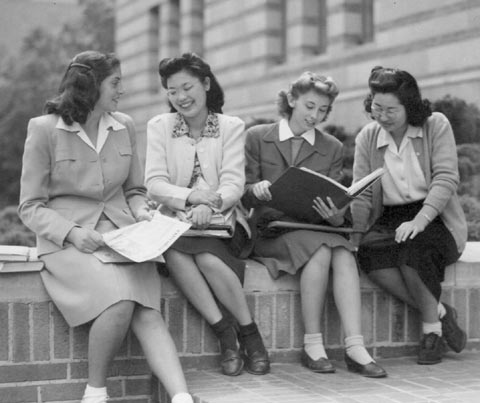
Another female Japanese artist of note, Gyo Fujikawa, who had worked in the advertising art department of Disney in the early-1940s, and was responsible for designing the elaborate Fantasia theater program that was given to audiences during its initial theatrical engagement.
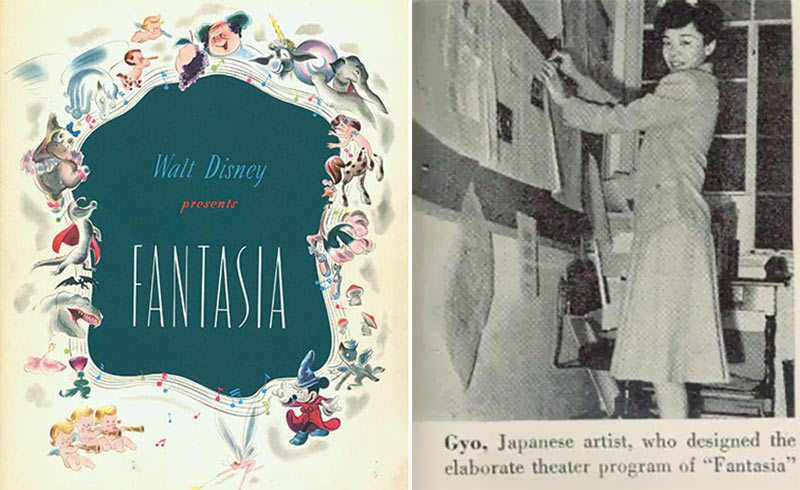
Fujikawa escaped internment by staying on the East Coast, where Japanese people were not detained by the government, and enjoyed a long career as an illustrator. This excerpt from her L.A. Times obituary explains more about her story:
It was Disney who Fujikawa said changed the way she handled bigots during World War II. Unlike her parents and younger brother, she escaped internment because she was living in New York; only Japanese residing on the West Coast were sent to the camps. But Fujikawa traveled frequently, and when people became suspicious of her, she often told them she was really Anna May Wong, the Chinese American actress. According to her nephew, Fujikawa took secret delight in this masquerade.
But when she told Disney that she often lied about her heritage, he exploded. “Damn it! Why should you say that? You’re an American citizen,” he said.
“From that moment on,” Fujikawa recounted recently, “that’s exactly what I did tell them.”
Below are a couple newspaper articles about Gyo Fujikawa. One piece is from 1935, before she joined the Disney studio, and the other piece is from 1958, after she’d established a successful career as an illustrator in New York City:
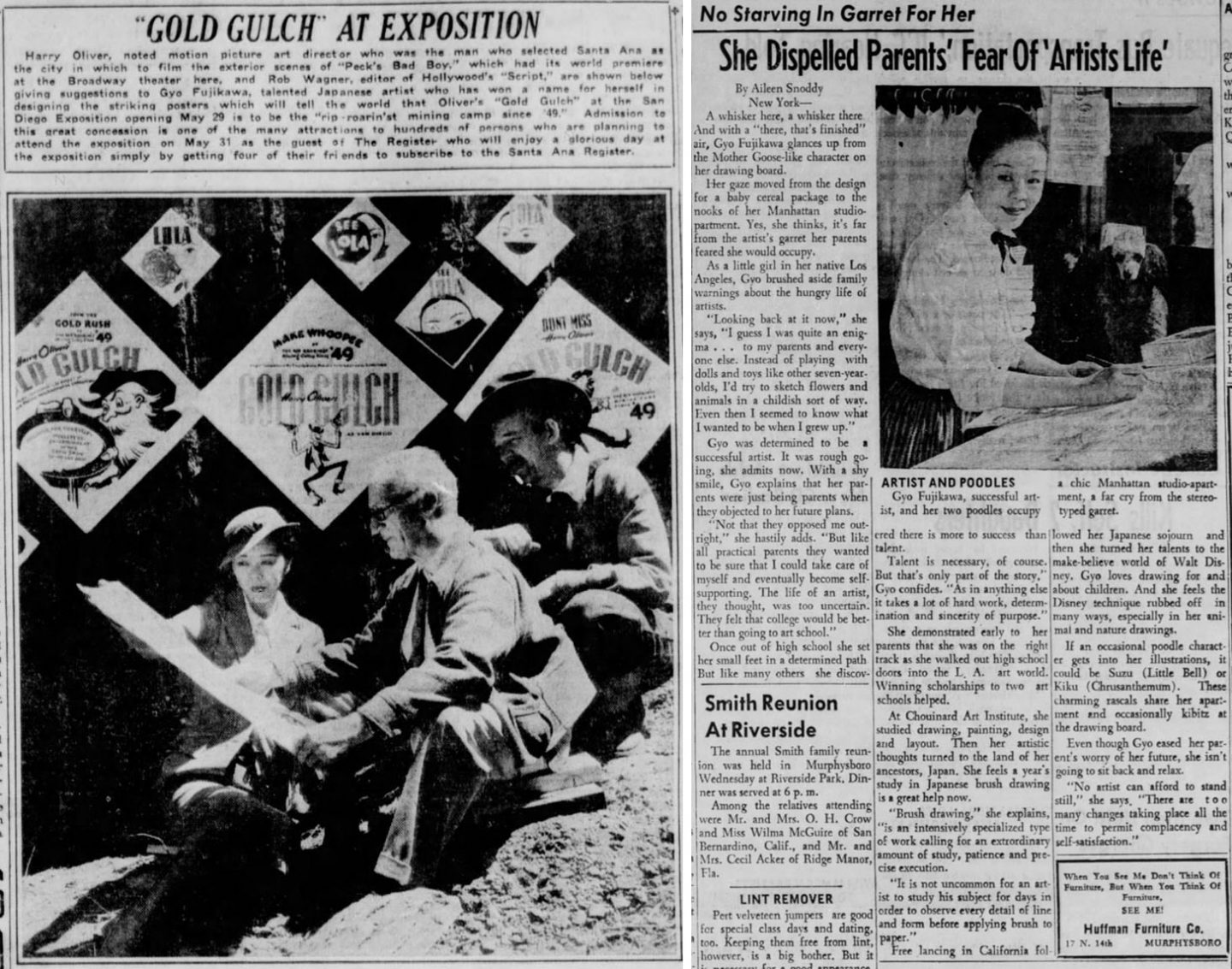
San Jose, California-born Jimmy Murakami was eight years old when he was interned at Tule Lake in North California. “I was very, very bitter to be an American citizen treated this way,” he said in an interview many years later. “My older sister died in the camp and the rest of us came out pretty bad.”
In the 1950s, Murakami went to Chouinard art school and was hired at United Productions of America (UPA) where he worked on the groundbreaking Boing Boing Show. Afterwards, he globetrotted around the world, working at many different studios: Pintoff Productions in New York City, Toei Animation in Tokyo, TVC in London, and various studios in Italy, before he returned to Los Angeles to launch his own commercial studio, Murakami-Wolf, in 1965. He later worked on British classics like The Snowman and When the Wind Blows before settling down in Dublin.
Here’s a video of Murakami recounting the comical story of how he and his brother had to come up with American names when they started attending school and unintentionally used the same name:
The youngest artist of the bunch is Willie Ito, who was born in 1934. He was placed into a desert concentration camp in Topaz, Utah, at the age of seven. In time, Ito also attended Chouinard and was hired in July 1954 at Disney, where he worked as an inbetweener on Lady and the Tramp.
Ito spent much of the 1950s working at Warner Bros. in Chuck Jones’ unit, and later worked on Bob Clampett’s Beany & Cecil tv cartoons, before becoming a key artist at Hanna-Barbera throughout the 1960s and 1970s.
He’s pictured below with layouts artists Jerry Eisenberg (seated) and Dick Bickenbach from the filming of the 1963 Hanna-Barbera tv special TV special Here Comes A Star (photo via Yowp blog).
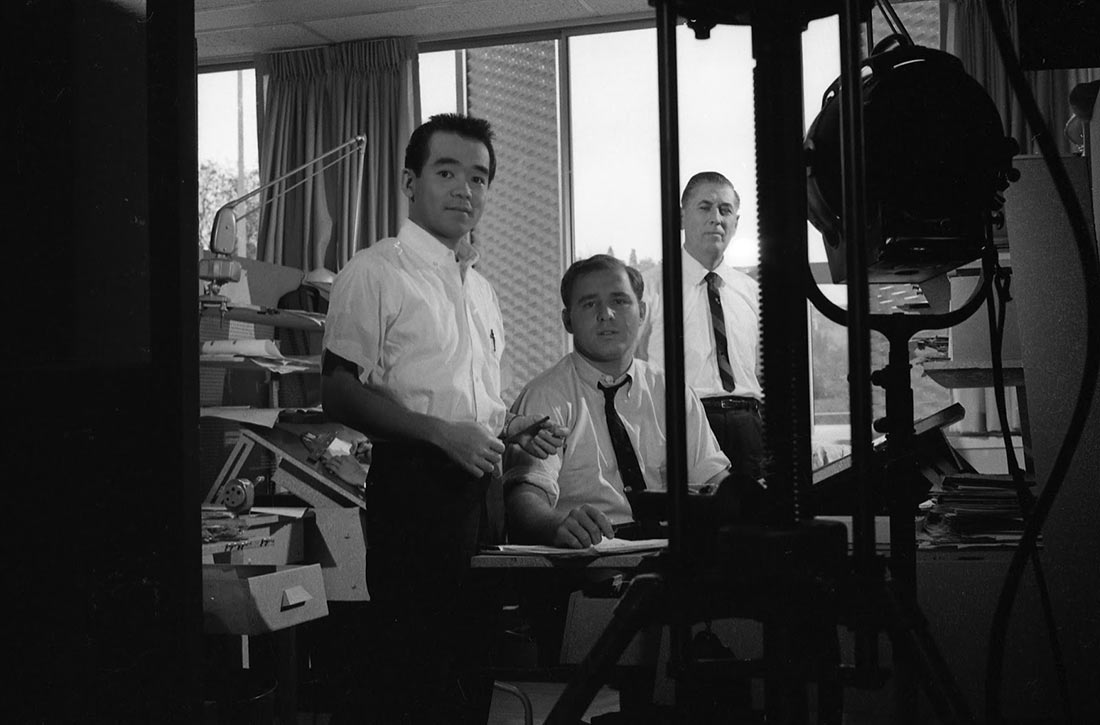
If anybody can add more details about these artists or other Golden Age Japanese artists, please share.

.png)